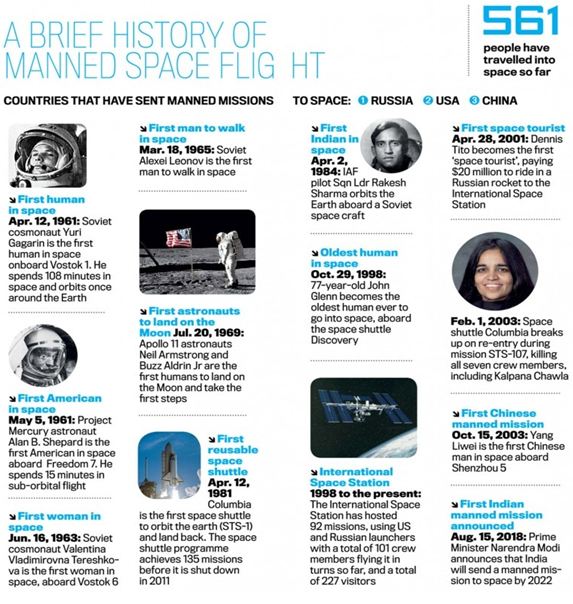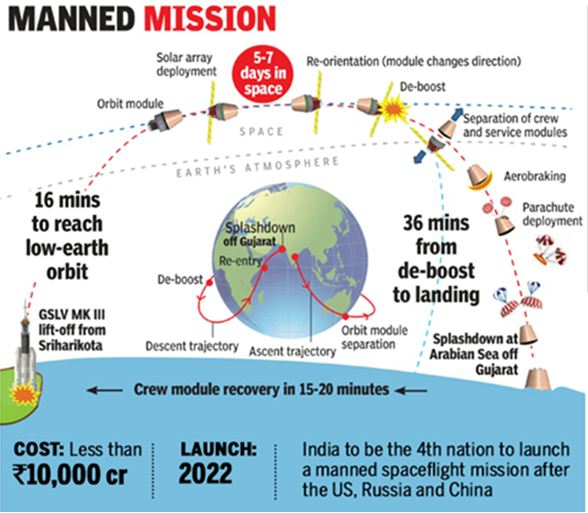ForumIAS announcing GS Foundation Program for UPSC CSE 2025-26 from 27th May. Click Here for more information.
What is Gaganyaan Mission?
Gaganyaan is India’s first Human Space Flight Programme to be launched by Indian Space Research Organisation (ISRO) by 2022. The programme will make India the fourth nation in the world to launch a Human Spaceflight Mission. So far, only the USA, Russia and China have launched human spaceflight missions.
A brief history of Human Space Flight:
Timeline of Gaganyaan Mission
2004: ISRO Policy Planning Committee recommends manned space mission
2006: National committee comprising 80 scientists and technocrats endorses proposal
2007: First public announcement of the human space programme
2009: Another committee, discusses the desirability and feasibility of the programme and expresses support
2010: Failure of GSLV-D3
2010: Failure of GSLV-F06
2014: Successful testing of experimental flight of GSLV Mk-III; this also successfully tests an experimental crew module, demonstrating re-entry capability
2017: First ‘developmental’ flight of GSLV Mk-III
2018: First successful flight of the crew escape system
Objectives of the Mission:
- Enhancement of science and technology levels in the country
- A national project involving several institutes, academia and industry
- Improvement of industrial growth
- Inspiring youth
- Development of technology for social benefits
- Improving international collaboration
Relevance of a Manned Space Mission for India:
- Boost to industries: The Indian industry will find large opportunities through participation in the highly demanding Space missions.Gaganyaan Missionis expected will source nearly 60% of its equipment from the Indian private sector.
- Employment:According to the ISRO chief, the Gaganyaan mission would create 15,000 new employment opportunities, 13,000 of them in private industry and the space organisation would need an additional manpower of 900.
- Technological development: Human Space flights are frontier field in the science and technology. The challenges the Human Space Flights provide to India, and the benefits accruing from taking up those missions will be very high and will lead to further thrust for technological developments in India
- Boost to research: It will boost good research and technology development. With a large number of researchers with proper equipment involved, HSF will thrust significant research in areas such as materials processing, astro-biology, resources mining, planetary chemistry, planetary orbital calculus and many other areas
- Motivation: Human space flight will provide that inspiration to the youth and also the national public mainstream. It would inspire young generation into notable achievements and enable them to play their legitimate role in challenging future activities
- Prestige: India will be the fourth country to launch human space mission. The Gaganyaan will not only bring about prestige to the nation but also establish India’s role as a key player in the space industry.
Critical Technologies for Human Space Flight (HSF):
According to ISRO, most of the indigenously developed technologies required for the mission has already been tested. These include crew module re-entry, crew escape mechanism in case of a glitch during launch, a deep space network and the astronaut’s space suit.
- Orbital Module: Divided into a crew module to house the astronauts and a service module that maintains the speed and orientation of the spacecraft using rocket motors apart from the power supply generated from solar sails.
- Crew Escape System: In case of a malfunction at launch, crew capsule will be ejected to a safe distance
- Integration facility: for integrating orbit module with launcher and modifying Launchpad for human interface
- Crew Module: Has to be tested for maintaining temperature and pressure comfortable for humans
- Deep Space Network: Need to track the module 24*7 as it orbits the earth
- Re-entry and Recovery system: System to withstand high temperatures (due to friction with the air) when the spacecraft re-enters earth’s atmosphere.
- ISRO scientists successfully demonstrated the re-entry technology to keep the astronauts cool and safe when they carried out a Crew Module Atmospheric Re-entry Experiment (CARE) in December 2014.
- Mission Control: Monitors and communicates with the orbiter and astronauts throughout the mission
- Rocket Launcher: The GSLV Mark III has been modified to improve reliability and accommodate orbital module
GSLV Mk III:
- GSLV Mk III is a three-stage heavy lift launch vehicle developed by ISRO.
- It is designed to carry 4-ton class of satellites into Geosynchronous Transfer Orbit (GTO) as opposed to the GSLV Mk II which can only place 2 tonne class of satellites
- It uses an indigenous Cryogenic rocket stage (LVM 3) which also makes it capable of placing heavy payloads into Low Earth Orbits of 600 km altitude.
- It is also capable of sending manned missions to space but the launcher has to be human-rated
- Recovery logistics: ISRO will interface with the Navy to pick up the astronauts when the crew module splashes down.
- Astronaut Training: Crew has to be trained to operate in zero gravity, withstand high g-forces on launch and re-entry. ISRO might seek foreign collaboration for astronaut training.
Challenges:
1.Technological Challenges
- Launcher: Though the GSLV Mk III has been modified to enable human space flights, to be human rated and fail-safe. Former ISRO chairman K. Radhakrishnan points out that for a human space flight, the launcher must have a reliability of 98% or above, or only two failures in a 100 launches.
- Crew Escape System: It is important to develop a crew escape system to prepare for any emergency from the launch phase onwards and ensure the reliability of such a system is as high as to allow a failure rate of only one in 500 launches.
- Astronaut Training:India does not have facilities for rigorous and focused training, such as centrifuges to experience g-forces and aircraft to simulate zero gravity conditions.
2.Threat from Space Debris:There is increasing threat of Space debris in the low earth orbits which can result in depressurization of the cabin of the crew module in case of collision with small debris.
3.Financial Implications: Human space flight missions are not one-time investments required for demonstrating national capability buthas to be continued human space flight pursuit with national gain. Therefore, the financial implications are of a concern
4.Political commitment: Ensuring political commitment for HSF in the democratic, multi-party framework of India – which has to deal with aspirations of Indian society is a major challenge
Way Forward:
- It is important to ensure engagements at political level to obtain long term commitment for India’s human space flight missions
- Financial implications of a long-term human space-flight programme development should be assessed and the returns and benefits should be clearly articulated
- It is important to overcome the technological challenges to ensure a safe, successful manned space mission. International collaboration in this domain can help India ensure a robust technology for its HSF programme.
- Selection of Indians for astronauts will be an important step. Procedures and specifications for astronauts and a rigorous selection process is suggested.






